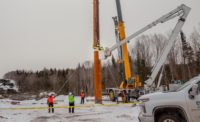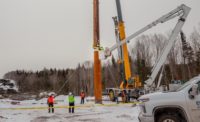Telecommunications
DIY Subsea Cable Project Delivers Broadband to Remote Maine Island Community
The Isle au Haut’s universal broadband activation is expected to be completed by the end of January

Residents of the Isle au Haut, a remote, unbridged Maine island community, banded together to complete a subsea cable project that will deliver universal broadband service to the community for the first time when the cable is commissioned at the end of January.
Photo courtesy Pioneer Consulting
For the Isle au Haut’s roughly 70 residents, spending the last eight years procuring and installing a subsea telecommunications cable delivering universal broadband service to the unbridged remote Maine island for the first time has truly been a community effort.
Many consultants, contractors and manufacturers didn’t even respond to residents inquiring about purchasing and installing the 10-kilometer cable for the island—half of which is occupied by portions of Acadia National Park.
“We had no experience sourcing subsea cable and pursued options through research and cold calls,” says Sue Foelix, one of the island’s four broadband committee members.
The community finally hired Hoboken, N.J.-based Pioneer Consulting in January 2023 to conduct a feasibility study for the approximately $150,000 subsea cable installation, a critical part of the overall $1.2 million broadband internet project.
“Unlike most of our long-haul, international projects, Isle au Haut has given us the opportunity to work directly with the end-users, the people themselves, who will benefit from this broadband service,” said Gavin Tully, managing partner at Pioneer Consulting.
Maine officials helped hire global IT services provider, Axiom Technologies, for the project funded by a $1.1 million grant from the National Telecommunications and Information Administration—part of a larger $28 million initiative administered by the Maine Connectivity Authority to support broadband expansion into underserved rural communities. The project received an additional $123,000 in state funding.
Installed in November, the subsea cable will deliver universal broadband internet to the island after Axiom finishes working on the final internet backhaul service on the landside connection in Stonington on Deer Isle, which has terrestrial connections to the mainland. Service to customers is expected no later than the end of January. It’s been a long road since residents first started researching the project eight years ago, including the required state and U.S. Army Corps of Engineers permits. Permitting took approximately one year, with the Army Corps approval coming in November 2023.
“Our community is excited about the new, faster internet service on the horizon,” says Abigail Hiltz, the town’s first selectperson and tax assessor chairperson.
On a Shoestring Budget
Residents initially considered building a less expensive microwave communications tower. But with half of the island comprising Acadia National Park, “the idea was not popular since it would impact the view,” Foelix says. “We had to work through technical and financial feasibility to come to the best decision.”
Tully noted that a subsea cable is ideal for communities like Isle Au Haut because it’s a future-proofed system.
To keep costs down, Pioneer worked out a deal with SubCom, a Newington, N.H.-based telecommunications cable manufacturer, to allow island residents to hire their own truck to transport the cable.
“SubCom typically would not even entertain an order for such a small project, working for the likes of Google,” says Bob Munoz, an undersea cable consultant at Pioneer.
For Munoz, the project was also much more low-tech and low-cost compared to the hundreds of million dollar transatlantic and transpacific subsea systems projects requiring cables thousands of kilometers long that he typically commissions. “This is probably the shortest cable I will ever lay,” he says.
Once the 1-in.-dia special purpose application cable was sourced, Pioneer’s team made plans for installation. While surveying the site, Munoz met Guy Parker, an island clammer who engineered the route for laying the 1983 power cable that connects to the mainland and allows residents to power their generators. Parker knew the ocean floor so well he agreed to mark a path for the new line with buoys that helped the team lay the cable. While sophisticated sonar and mapping tools are typically used to map cable routes, “In this case, since the route was short and within diver depth, Parker was able to swim it and visually pick the route,” Munoz says.
Utilizing Parker’s 1983 drawings of the “zig zag” electric cable route, Munoz tried to closely follow it without laying the new cable on top of the older one. Obtaining data from the 1983 seabed map and a Garmin fishing sonar device obtained from Isle au Haut Electric Power Co. also helped the team cost-effectively map a route for the new cable.
Once the team found a barge to assist with cable laying, Pioneer helped the town hire Gaeaquatic, a Greece-based engineering and construction consultant, to supply three workers to execute the job on a tight budget, Munoz says. Foelix says the town hired three certified divers, but Gaeaquatic and the town worked out a deal for Gaeaquatic to supply an additional four workers for the safety and success of the installation. To stay within budget, the town agreed to cover airfare, meals and lodging for the additional workers. “They showed up with a team of seven, including two men who drove up with a truck and equipment,” she says.
When it came time to lay the cable on Nov. 8, winds gusted up to 30 knots on the barge, Munoz recalls, so the team started working around 4:30 a.m. on Nov. 10 and finished in approximately seven hours.
“It took three hours for the barge to stretch the cable across to Stonington before the installation was completed at 11:30 that morning,” Munoz says.
Island residents pitched in to prepare the cable’s mainland landings. At Stonington they placed conduit from the water up the pier and across the road to the terrestrial fiber network connection, Munoz says. On the island, they crossed the pier installing about 100 meters of conduit to pull cable through, then hand buried it, he says. “I grabbed a shovel and helped dig some of the trench,” he recalls.” It was a do-it-yourself project.”




